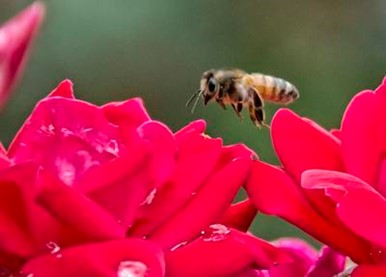‘Bee’ kind this year by planting a pollinator garden
By: Christine Holtz – erachristineh@gmail.com
A bee hovers above a flower in Veterans Square. – Era file photo
Honey bees are the essential workers of nature, ensuring that crops are pollinated, not to mention providing humans with sweet, delicious honey.
The United States Department of Agriculture estimates that pollinators, such as bees and butterflies, help pollinate roughly 75 percent of the world’s flowering plants. Additionally, they pollinate around 35 percent of the world’s food crops, including fruits and vegetables. To make a long story short, without honey bees and other pollinators, our food supply would be in great peril.
Honey bees and other pollinators are in danger due to a variety of factors, including pesticides, drought, habitat destruction, nutrition deficit, air pollution, global warming and more, according to Greenpeace.org. There are ways people can help though — one way is by planting a pollinator-friendly garden to ensure they have sufficient pollen and nectar.
Penn State Extension provides a plethora of knowledge on planting such gardens, such as the following:
-Choose plants native to the region; natives will flourish without pesticides and fertilizers, which can be harmful to bees.
-Due to the diversity of pollinator types, choose nectar-rich and pollen-rich flowers with a range of shapes, size and colors. ‘Generalist’ pollinators can utilize a wide variety of flowers, whereas ‘specialists’ need a specific diet and may only be able to feed from one or two types of plants. To attract the most diversity of pollinators, choose plants such as Joe Pyes, goldenrods and milkweeds.
-Avoid modern hybrids, as many have been manipulated for larger blooms/greater color and have lost their ability to produce nectar and pollen. Additionally, during the breeding process, some flowers may become so complex that pollinators can’t locate the nectar.
-Have several different plants in bloom from early spring through late fall. Some pollinators may appear in the spring, while others don’t appear until mid-summer. Overlapping bloom times will ensure pollinators always have something nutritious.
-Plant in drifts. When purchasing plants, try to get at least three or more of one kind and plant them near one another; pollinators are more likely to find them this way.
-Avoid landscape fabric and mulch. Instead, plants of varying heights planted close together will form a weed barrier much stronger than a bed of mulch.
-Save perennial garden cleanup for spring, as pollinators overwinter in different life stages. Some may attach to plants or overwinter in leaf litter, while others may overwinter in hollow stems. To protect overwintering pollinators, don’t cut down perennial gardens until early April, keeping beds of leaves intact through the winter.
As many plants sold at garden centers come from Europe and Asia, one may need to do some searching to purchase native host plants for butterflies. For help, call the Master Gardeners at 814-887-5613 or go to the Pennsylvania Native Plant Society website at http://www.panativeplantsociety.org/ for a resource list.









